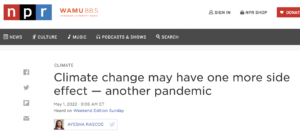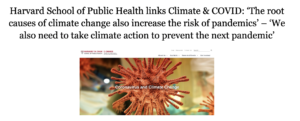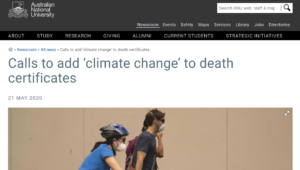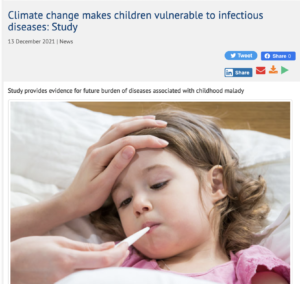Climate Depot Special Report
New England Journal of Medicine – December 1, 2022
https://www.nejm.org/doi/full/10.1056/NEJMp2213814
It Ain’t Over Till It’s Over…but It’s Never Over — Emerging and Reemerging Infectious Diseases
List of authors. Anthony S. Fauci, M.D. – From the National Institute of Allergy and Infectious Diseases, National Institutes of Health, Bethesda, MD.
N Engl J Med 2022; 387:2009-2011
DOI: 10.1056/NEJMp2213814
Fauci Excerpts: “As I prepare to step down from my dual positions at the National Institute of Allergy and Infectious Diseases (NIAID), where I have been a physician-scientist for 54 years and the director for 38 years, a bit of reflection is inevitable.”
…
Fauci: “Today, there is no reason to believe that the threat of emerging infections will diminish, since their underlying causes are present and most likely increasing. The emergence of new infections and the reemergence of old ones are largely the result of human interactions with and encroachment on nature. As human societies expand in a progressively interconnected world and the human–animal interface is perturbed, opportunities are created, often aided by climate changes, for unstable infectious agents to emerge, jump species, and in some cases adapt to spread among humans.”
#
Related:
Fauci, in a September 3, 2020 paper published in the biomedical journal Cell Press: “Living in greater harmony with nature will require changes in human behavior as well as other radical changes that may take decades to achieve: rebuilding the infrastructures of human existence…”

#
Former NYT reporter Alex Berenson responds: “But, see, if #COVID-19 turns out to be a testing-driven lil-bit-worse-than-a-bad-flu year, what then? Maybe we WON’T need to redesign all of human existence because some 79-year-old bureaucrat wants us to?”
“Why does Dr. Anthony Fauci, a division-level bureaucrat whose day job includes the word ‘allergy,’ think his brief now includes redesigning all of human society? And how monstrous must his ego have become for him to be willing to say so publicly?” Berenson asked.
#
2022: State Department official joins panel linking COVID origin to ‘human impact on ecosystems’
 .
. 


 .
.
“Climate change is creating a new age of infectious dangers.” Climate Change Could Spark Future Pandemics – “The research, published in Nature, uses modeling to map how climate change could shift the geographic ranges of 3,100 mammals species and the viruses they carry by 2070. … The findings suggest that climate change could “easily become the dominant [human] driver” of cross-species virus transmission by 2070, the authors say.”
#
Marc Morano: “They want to keep both climate and COVID fears humming along to push their so-called solutions, so what better way than to merge the two issues!? Worried about COVID-19, then support the UN Paris climate pact, the Green New Deal, carbon taxes, etc. or else you are a gramma killer!”
Marc Morano comments: “The climate movement is now merging their focus on linking viruses to “climate change” and thus making fighting climate change a part of fighting deadly viruses. Global warming promoters know that they should never let a crisis go to waste. They are pouncing on any opportunity to inject climate change into the COVID-19 issue.
They want to keep both climate and COVID fears humming along to push their so-called solutions, so what better way than to merge the two issues!? Worried about COVID-19, then support the UN Paris climate pact, the Green New Deal, carbon taxes, etc., or else you are a gramma killer!
The activists will then attempt to piggyback efforts like the Green New Deal as a part of future virus-fighting strategies. Already, media reports are claiming more Green New Deal Style policies are needed because ‘efforts to cut greenhouse gas emissions may not be enough to stave off the increased transmission of viruses between species.’ Doctors are now clinically diagnosing patients with ‘climate change” and there are calls from academics to add ‘climate change’ as a cause of death on death certificates. In short, climate change can no longer survive on its own, it needs to be linked with COVID fears to prop it up as a concern.
The climate establishment spent decades trying to scare us about overpopulation, global cooling, the amazon rainforest (allegedly disappearing), and finally, climate change and they utterly failed. A virus came along in 2020 and they realized that this cut across ideologies, cut across political affiliation and they were able to declare an emergency and suspend normal democracy. They were able to achieve their one-party state with an unelected bureaucracy.
Meanwhile, the data does not support this latest speculative computer model COVID/Climate scare story: See: H. Sterling Burnett’s analysis: Science Crushes Claimed Link Between COVID & Climate– ‘In reality, if a modestly warming Earth has any impact on viruses and pandemics, it is to make them less likely and less severe…Historically, we know that the Black Plague arose and ran rampant in Europe and elsewhere during the Little Ice Age.’
#
Bill Gates: “It’s quite clear in this case, [Covid] came across through animals. And almost all our diseases, like HIV, crossed over from chimpanzees in Africa quite some time ago; Ebola came from bats, this also, with one step in between came across from bats.” – “So it’s going to keep happening, particularly with climate change where we’re invading a lot of habitats. And you want to catch it as soon as you can.”
US News & World Report: Climate Change Will Make Pandemics Like COVID More Likely: Report
Excerpt: Planet Earth is growing hotter, forcing different animal species to migrate to new areas and interact with other unfamiliar creatures at an increasing rate. That phenomenon could have dire consequences to human health, a new study says, raising the odds for new viral illnesses such HIV (which originated in primates), as well as pandemics such as COVID-19, which many believe originated in a coronavirus that jumped from species such as bats or pangolins to people. Potential new contacts between different species are expected to essentially double over the next 50 years, increasing the risk that other viruses will jump from animal to animal and eventually into humans, researchers predict. Viruses will move to a new animal species at least 15,000 times by 2070 as a result of migration driven by climate change, according to projections published in the journal Nature.
#
NPR: Climate change may have one more side effect — another pandemic –
Excerpt: NPR’s RASCOE: And you and your colleagues built a computer model to project how viral jumps between species might change in a warming world. What type of information did you use to build that model, and what did your results show?
CARLSON: So we’ve been running simulations on and off for about three years. We take huge climate models. We project where animals can go to track their habitats, and then we use machine learning to figure out what animals might be able to share viruses with each other. What we find is that everybody’s on the move. We found that most species are probably going to have at least one chance to pick up new viruses. And at a sort of global scale, this is really concerning news when it comes to human health because it means that species like bats that have coronaviruses, Ebola virus, all of these things we worry about, they’re probably going to need to share some of the same places that we already live. And they’re going to be sharing a ton of viruses in our backyard.
#
Excerpt: For the world’s viruses, this is a time of unprecedented opportunity. An estimated 40,000 viruses lurk in the bodies of mammals, of which a quarter could conceivably infect humans. Most do not, because they have few chances to leap into our bodies. But those chances are growing. Earth’s changing climate is forcing animals to relocate to new habitats, in a bid to track their preferred environmental conditions. Species that have never coexisted will become neighbors, creating thousands of infectious meet-cutes in which viruses can spill over into unfamiliar hosts—and, eventually, into us. Many scientists have argued that climate change will make pandemics more likely, but a groundbreaking new analysis shows that this worrying future is already here, and will be difficult to address.
#
Forbes: Climate Change Could Spark Future Pandemics, Study Finds
Global warming could fuel future pandemics by dramatically increasing the risk viruses will jump into humans from other animals, researchers warned Thursday, illuminating another hidden and far-reaching cost of the climate crisis.
As the world gets warmer, many animals will be forced to find new places to live, taking any parasites and pathogens they carry along for the ride, researchers wrote in Nature. The researchers examined how climate change could alter the geographic range of some 3,100 mammal species between now and 2070 and how this might affect the transmission of viruses between species.
Climate change ‘already’ raising risk of virus spread between mammals –
Excerpt: Mammals forced to move to cooler climes amid global warming are “already” spreading their viruses further – with “undoubtable” impacts for human health, a new study says. The research, published in Nature, uses modelling to map how climate change could shift the geographic ranges of 3,100 mammals species and the viruses they carry by 2070. …
The findings suggest that climate change could “easily become the dominant [human] driver” of cross-species virus transmission by 2070, the authors say.
#
Climate Change To Increase ‘Zoonotic Spillover’ — Yes, That’s Very Bad
#

Dr. Aaron Bernstein, Director of Harvard Chan C-CHANGE: “We also need to take climate action to prevent the next pandemic.” … “Climate change alters how we relate to other species on Earth and that matters to our health and our risk for infections.” … “Many of the root causes of climate change also increase the risk of pandemics.”
The climate movement is now merging their focus on linking viruses to “climate change” and thus make fighting climate change a part of fighting deadly viruses.
The activists will then attempt to piggyback efforts like the Green New Deal as a part of future virus-fighting strategies.
Global warming promoters know that they should never let a crisis go to waste. They are pouncing on any opportunity to inject climate change into the COVID-19 issue including attempts to make sure that federal stimulus bills include going in the “right direction toward decarbonization.”


Rolling Stone mag: “How Climate Change Is Ushering in a New Pandemic Era”: The author writes, “[a] warming world is expanding the range of deadly diseases and risking an explosion of new zoonotic pathogens from the likes of bats, mosquitoes, and ticks.” The article is long on assertions, touching anecdotes, and personal stories but short on facts and scientific evidence.
H. Sterling Burnett: Climate alarmists and major media outlets are deceitfully exploiting the coronavirus pandemic to tell the public lies that climate change makes pandemics more likely and severe. In reality, the evidence is quite clear that warmer temperatures make pandemics and underlying outbreaks of viruses like the flu less frequent and severe. In a March 24 editorial in The Hill, Vinod Thomas, former direct-general of the Independent Evaluation Group at the World Bank Group, writes, “There is a link to pandemics, like COVID-19, and a warmer world….” Thomas’s claim follows many others in the media. For example, a recent Time magazine article states, “I have no evidence that climate change triggered this particular virus to jump from animals to humans at this particular time, or that a warmer planet has helped it spread. That said, it’s pretty clear that, broadly speaking, climate change is likely to lead to an uptick in future epidemics caused by viruses and other pathogens.” …
Numerous studies demonstrate that transmissible diseases like the flu and the coronavirus are far more prevalent and deadly during the late-fall, winter, and early spring, when the weather is cold and damp, rather than in the summer months when it is warm and dry. That is a reason the flu season runs from fall through early spring, and then peters out. And colds, while not unheard of, are less common in the summer as well.
Chapter 7 or the Non-governmental International Panel on Climate Change’s report of Climate Change Reconsidered: Biological Impacts details the results of dozens of peer reviewed studies and reports showing premature deaths from illness and disease are far more prevalent during colder seasons and colder climate eras rather than during warmer seasons and warmer climate eras.
In 2010, British Broadcasting Channel’s health correspondent Clare Murphy analyzed mortality statistics from the UK’s Office of National Statistics from 1950 through 2007 and found, “For every degree the temperature drops below 18C [64 degrees Fahrenheit], deaths in the UK go up by nearly 1.5 percent.”
U.S. Interior Department analyst Indur Goklany studied official U.S. mortality statistics and found similar results. According to official U.S. mortality statistics, an average of 7,200 Americans die each day during the months of December, January, February, and March, compared to 6,400 each day during the rest of the year.
In an article published in the Southern Medical Journal in 2004, W. R. Keatinge and G. C. Donaldson noted, “Cold-related deaths are far more numerous than heat-related deaths in the United States, Europe, and almost all countries outside the tropics, and almost all of them are due to common illnesses that are increased by cold.”
More recently, in a study published in the Lancet in 2015, researchers examined health data from 384 locations in 13 countries, accounting for more than 74 million deaths—a huge sample size from which to draw sound conclusions—and found cold weather, directly or indirectly, killed 1,700% more people than hot weather. No, that is not a typo – 1,700% more people die from cold temperatures than warm or hot temperatures.
Contrary to the fear-mongering assertions in The Hill and Time, the overwhelming scientific evidence shows it is cold, not heat, that kills. Therefore, a modestly warmer world, with shorter, less severe winters, should result in fewer premature deaths from disease, viruses, pandemics, hunger, and other natural causes.
2021: Epic Fail: Chuck Todd Tries to Bait Anthony Fauci on Climate Change
BBC Excerpt: In one day, the average person breathes out around 500 litres of the greenhouse gas CO2 – which amounts to around 1kg in mass. This doesn’t sound much until you take into account the fact that the world’s population is around 6.8 billion, collectively breathing out around 2500 million tonnes of the stuff each year – which is around 7 per cent of the annual CO2 tonnage churned out by the burning of fossil fuel around the world.
So, on the face of it, we humans are a significant contributor to global warming. But, in reality, the CO2 we’re breathing out is part of a natural cycle, by which our bodies convert carbohydrates from CO2-absorbing plants into energy, plus water and CO2. As such, we’re not adding any extra CO2.











 .
. 





